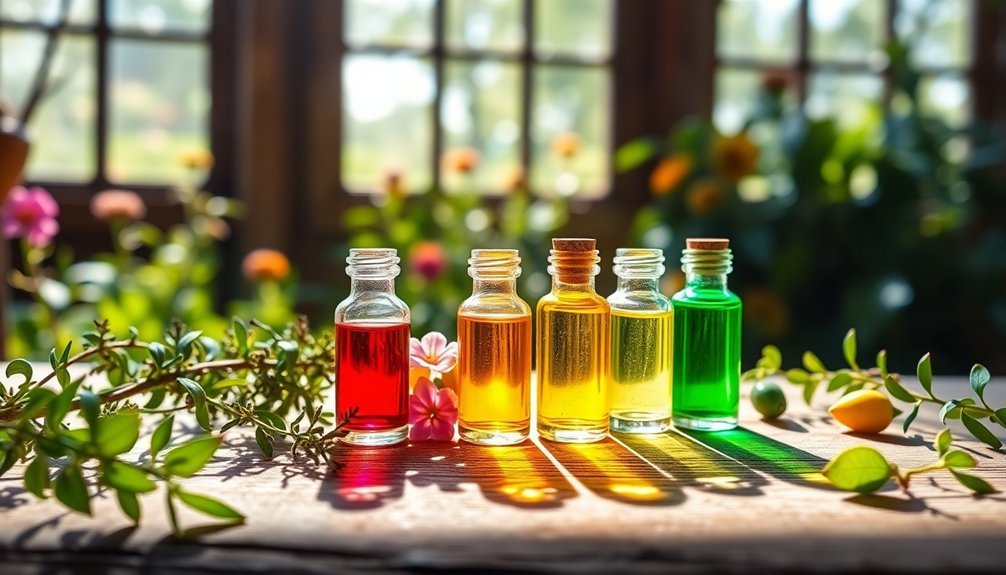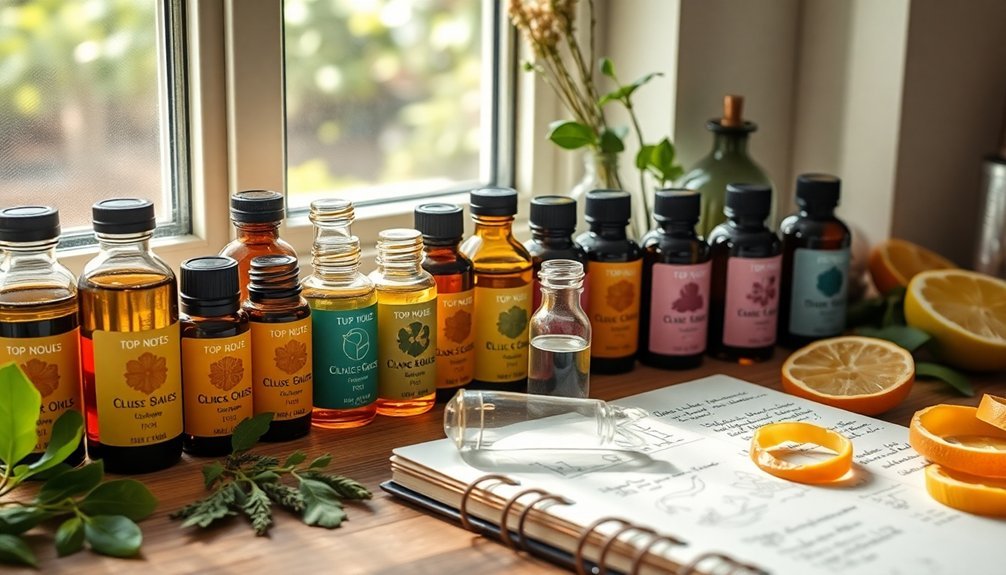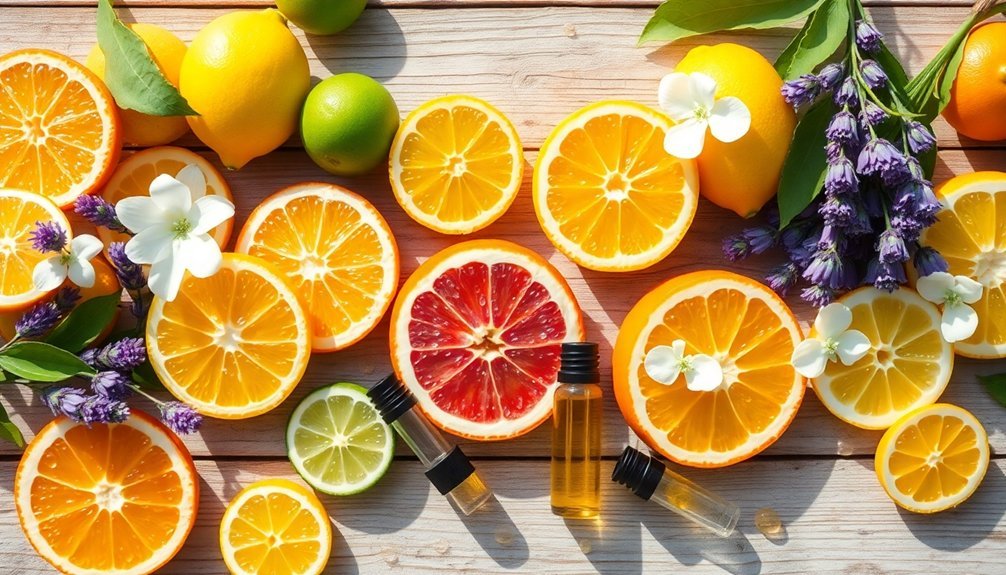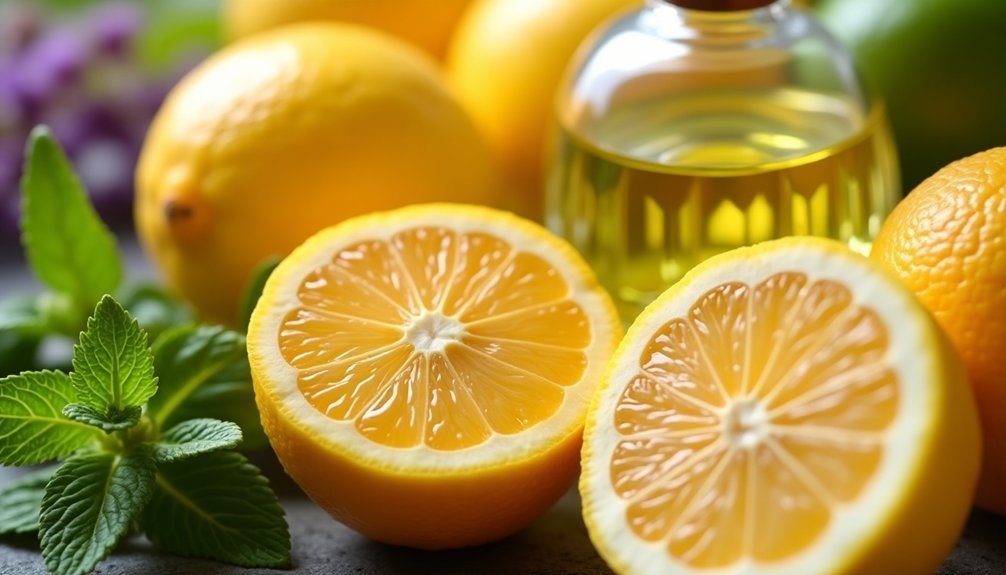When choosing top notes for natural perfumes, you'll want to start with bright, volatile oils like citrus and herbs that make up 10-30% of your blend. Focus on creating an impactful first impression that lasts 5-15 minutes before shifting to heart notes. Test combinations on your skin to guarantee proper balance, and don't overpower your blend with too many top notes. The journey into natural perfumery's aromatic secrets has only just begun.
Understanding the Magic of Top Notes in Natural Perfumes

What makes a perfume's first impression truly unforgettable? It's the magical dance of top notes, those fleeting yet powerful elements that make up 10-30% of your natural perfume composition.
When you're creating your fragrance experience, these initial notes are your opportunity to captivate the senses and set the stage for an enchanting olfactory journey.
You'll find that invigorating citrus oils like lemon, bergamot, and grapefruit, along with vibrant green notes such as basil and mint, create that essential lasting impression.
These volatile ingredients work with your skin chemistry, triggering emotional responses and memories.
To achieve a harmonious blend, you'll want to verify your top notes complement rather than overwhelm the heart and base notes, allowing your creation to unfold naturally and elegantly throughout its wear time.
Essential Properties of Effective Top Notes
Mastering top notes requires understanding their essential characteristics. When you're crafting a fragrance, you'll find that effective top notes contain light, volatile molecules that create an immediate impact lasting 5-15 minutes. Essential oils like lemon, bergamot, and grapefruit are perfect examples that deliver an invigorating olfactory experience.
Your personal scent preferences matter, but remember that balance is vital. Don't let strong top notes overpower your heart notes – this maintains depth and complexity in your creation.
You'll want to explore different categories like fruity, green, and aromatic notes to build an intriguing profile. These choices aren't just about lasting power; they're about creating emotional connections through the olfactory system.
Popular Citrus and Herbal Top Note Combinations

You'll discover endless possibilities when combining zesty citrus notes like lemon and bergamot with fresh herbal elements such as basil and peppermint in your perfume creations.
These dynamic pairings create a vibrant opening that captures attention while setting the stage for deeper middle and base notes to emerge.
Fresh Citrus Pairings Explained
While citrus and herbal top notes each possess their own distinct charm, combining them creates an exceptionally vibrant and multifaceted opening for perfumes.
When you're crafting invigorating fragrances, it's crucial to understand how citrus notes like lemon and bergamot interact with herbal notes such as basil and eucalyptus. These Natural Perfumery combinations deliver energizing experiences that last 5-15 minutes before shifting to deeper notes.
- Blend lemon with basil for a fresh, culinary-inspired opening
- Pair bergamot with eucalyptus for an uplifting, aromatic experience
- Combine grapefruit with herbal notes for a mood-enhancing effect
- Layer multiple citrus fragrance notes for extended freshness
- Balance zesty top notes with aromatic herbs to create depth
Herbal Brightness In Perfumes
The art of blending citrus and herbal top notes creates some of perfumery's most invigorating combinations. When you're crafting your fragrance, pairing bright citrus scents like lemon or bergamot with herbal top notes such as basil or peppermint adds remarkable depth and character to your creation.
These fragrance families work together to deliver a memorable first impression that's both revitalizing and complex. While these notes evaporate quickly, they serve an essential purpose in your perfume's composition.
The initial burst of energy and rejuvenation from citrus, balanced with the grounding qualities of herbs, sets the stage for the fragrance's journey. You'll find that this combination creates a harmonious opening that naturally leads your senses into the heart of the perfume, making it particularly suitable for daytime wear.
Balancing Zesty With Green
Building on the vibrant interplay between citrus and herbal notes, specific combinations stand out for their exceptional harmony and appeal.
When crafting natural perfumery, you'll find that balancing zesty top notes with green notes creates uniquely revitalizing experiences. Your citrus elements provide that initial burst of energy, while herbal components add depth and sophistication to maintain perfect balance.
- Pair lemon with basil for a bright, culinary-inspired harmony
- Combine bergamot and mint for an invigorating, spa-like sensation
- Blend grapefruit with violet leaf for a sophisticated, modern twist
- Mix orange with rosemary for a Mediterranean-inspired freshness
- Unite lime with fresh herbs for a dynamic, energizing effect
These carefully balanced combinations create distinctive top notes that shift smoothly into your fragrance's heart while maintaining their unique scents throughout the initial phase.
Balancing Intensity: The Art of Top Note Proportions

You'll need to carefully measure your top notes to create that essential first impression, as these volatile ingredients make up 10-30% of your perfume's composition.
When working with citrus oils and other bright top notes, remember they'll only last 5-15 minutes, so their initial intensity must be precisely balanced to avoid overwhelming the wearer.
Testing your blend on skin will help you perfect the proportions, ensuring your top notes harmoniously shift into the heart and base notes of your fragrance.
First Impressions Matter Most
Just as a handshake sets the tone for a first meeting, top notes create the essential initial impression of a fragrance that can make or break its appeal. When you experience that first spritz, the initial scents must blend well to deliver an invigorating zestiness that captivates without overwhelming.
Creating a well-rounded scent profile requires careful attention to the harmonious shift between layers, ensuring your fragrance journey unfolds naturally.
- Keep top notes between 10-30% of the total composition
- Choose citrus elements for an uplifting, fresh opening
- Balance intensity to avoid harsh first impressions
- Allow deeper layers to shine through gradually
- Consider how initial scents will complement middle and base notes
Blending For Perfect Harmony
Mastering the art of top note proportions requires a precise understanding of scent ratios and their interplay.
When you're blending top notes, remember they'll make up 10-30% of your fragrance composition and are highly volatile, meaning they'll evaporate quickly.
To achieve harmony in your perfumery, you'll want to carefully select complementary notes, such as combining citrus oils like Bergamot with green notes.
Don't let your top notes overpower the composition; instead, make certain they enhance the fragrance's initial impact while allowing a smooth shift to middle and base notes.
Keep track of your blending ratios in a perfume journal, noting which combinations work best.
This documentation will help you replicate successful formulas and fine-tune the intensity of your top notes for future creations.
Seasonal Considerations for Top Note Selection
The art of selecting seasonal top notes involves understanding how different scents resonate with each time of year.
You'll want to match the volatility of top notes with the season's characteristics. In warmer months, citrus notes like lemon and bergamot offer invigorating qualities that perfectly complement spring and summer's energy.
When autumn arrives, shift to spicier options, while winter calls for deeper scents that create lasting impressions.
- Choose floral top notes in spring to align with nature's blooming cycle
- Opt for light, citrus-based scents during summer's peak heat
- Incorporate spicy notes like ginger and cardamom for autumn's cozy atmosphere
- Select rich, cooling notes such as peppermint for winter
- Consider the seasonal temperature when evaluating the intensity of your chosen notes
Creating Signature Blends With Distinctive Top Notes

Crafting signature blends begins with selecting distinctive top notes that create an unforgettable first impression. You'll want to focus on bright, invigorating elements like citrus oils to captivate your audience's senses immediately.
Since top notes only last 5-15 minutes, they must seamlessly shift into your blend's heart and base notes for proper fragrance evolution.
To develop unique blends in natural perfumery, experiment with green notes like basil or violet leaf. These herbaceous additions can enhance your creation's complexity while maintaining a balanced fragrance.
Be careful not to overpower your signature scent with excessive top notes, as this can disrupt the overall harmony. Keep detailed records of your successful combinations in a perfume journal, allowing you to replicate and refine your distinctive blends over time.
Common Mistakes to Avoid When Choosing Top Notes
Successful perfume creation requires understanding what not to do with top notes just as much as knowing what works. In fragrance composition, avoiding common mistakes is essential for achieving the perfect balance in your overall scent profile.
You'll want to prevent overwhelming your blend while ensuring your chosen notes interact with skin chemistry appropriately.
- Don't exceed 10-30% of total fragrance with top notes, as this can disrupt the composition's harmony
- Avoid using too many citrus-based notes, which can overpower subtle middle and base notes
- Never select top notes without considering their compatibility with other layers
- Don't ignore how top notes interact with your unique skin chemistry
- Resist the urge to add excessive top notes, as their high volatility can lead to quick evaporation and imbalance
Pairing Top Notes With Complementary Middle Notes

Creating harmonious fragrances depends heavily on how well you pair your top notes with complementary middle notes. When selecting combinations, you'll want to take into account the aromatic profile of each note to guarantee they work together effectively.
For instance, citrus top notes blend beautifully with floral middle notes, while spicy top notes pair well with herbaceous ones.
To achieve a cohesive scent, look for middle notes that share similar olfactory qualities with your chosen top notes. You can enhance a fruity fragrance by pairing blood orange with peach, or create balance by combining light eucalyptus with heavier ylang ylang.
Remember to test your combinations on skin, as the interaction between notes can vary notably. This hands-on approach will help you discover which pairings create the most harmonious and complementary blends.
Storage and Shelf Life of Natural Top Note Oils
While natural top note oils offer vibrant aromas for perfumery, their delicate nature requires careful storage to maintain quality.
You'll find that most natural top notes have a shelf life of one to two years, but proper storage techniques can help preserve their potency and fragrance quality.
Keep your essential oils in dark glass bottles, tightly sealed to prevent oxidation, and store them away from direct sunlight and heat sources.
- Store top notes in a cool, dark place to maximize their shelf life
- Check your oils regularly for changes in scent or consistency
- Use dark glass bottles with secure caps to prevent oxidation
- Expect some natural separation without assuming spoilage
- Monitor potency changes to guarantee peak fragrance quality
Frequently Asked Questions
What Are the Best Top Notes for Perfume?
You'll find the best perfume top notes in citrus oils like lemon and bergamot, invigorating mint and eucalyptus, soothing florals like lavender and neroli, and fresh green notes like basil.
What Perfume Do Millionaires Use?
You'll find millionaires often wearing Creed Aventus, Tom Ford Tobacco Vanille, or Maison Francis Kurkdjian fragrances. They also invest in bespoke perfumes and limited-edition scents to maintain exclusivity and personal distinction.
How to Pick Out Notes in Perfume?
Start by smelling the perfume's initial burst (top notes), wait 30 minutes for middle notes to emerge, then let it settle for hours to detect base notes. Trust your nose's natural ability to identify scents.
How to Train Your Nose?
You'll strengthen your nose by smelling different scents daily, keeping a fragrance journal, studying essential oils, and practicing scent isolation. Take breaks between samples to avoid sensory fatigue and maintain accuracy.
In Summary
You've now mastered the fundamentals of selecting and working with top notes in natural perfumery. Remember to trust your nose, keep your blends balanced, and don't be afraid to experiment with unique combinations. Store your oils properly and pay attention to their shelf life. With these skills, you'll create memorable natural fragrances that capture attention from the very first note.





Leave a Reply